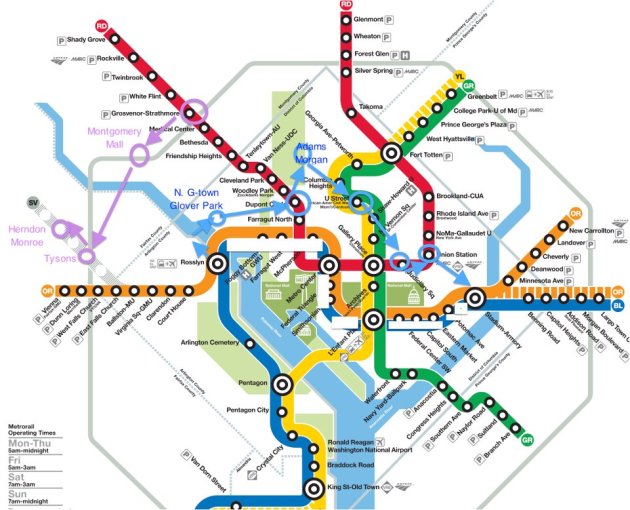Horseshoes, Hand Grenades, and Government Work
January 25, 2013 Leave a comment
Last year, I described my proposal for improving the WMATA metro system: basically, it’s captured in the picture below – basically, it involved one new Potomac bridge, one new under-Potomac tunnel, and a cross-town tunnel. I didn’t add in the link between Silver Spring and Grosvenor because that’s already in development by Montgomery County as light rail (due to the fetish of light rail in many places – even though it has the drawbacks of rail without the throughput of heavy rail).
I’m glad to see that society is starting to catch up: yesterday’s Washington Post included discussions about a major capital overhaul to the system designed to improve the carrying capacity, which will do some things but not every thing. (image below)

Washington Post’s rendering of proposed metro improvements
Half a loaf is better than no loaves, but I’m concerned about one of the fundamental omissions: the plan they’re describing does not add any Potomac crossings, and thus does not actually increase the aggregate throughput of getting people from Virginia to DC or Maryland. Additionally, it preserves the DC-centric plan, where there is no ability to bypass the city for those folks who live in Maryland and work in Virginia (or vice versa) – of whom there are a non-trivial number.
WMATA historically has made extremely short-sighted decisions about capital investment – the decision to build a two-track system rather than four-track means both that express trains are completely out and also that any issue on any one track or train completely screws up the whole line. The decision to build very high stations with vaulted ceilings means that overlapping lines are harder to accomplish. The decision to build the Silver line through Tysons as an overhead line means that it will be vastly more vulnerable to weather disruption, and maintenance will be more expensive (because fixing problems 30′ above ground is trickier than underground or at grade, likewise snow and water removal gets trickier). The decision to eschew multiple points of interconnection between the red line and other lines means that those interconnections are a complete balagon, and the decision to build the system to spec rather than to 400% of spec means that they routinely under project the actual demand for service. This is not to mention whoever had the brilliant idea about exposing escalators to rain.
I’m a fiscal conservative – I only want the government to spend money in limited and appropriate ways. However, it’s better to spend the money to do it right the first time, rather than spending a lot of money to not solve the problem. The new plan will solve problems inside the city, but I don’t see why, in absence of a second under-Potomac tunnel, it would solve problems between Virginia and the city, which are a lot of them. The improvements to Red-line Marylanders will be modest – the ability to ditch at Farragut is a long-overdue improvement (although you see that my recommendation would allow Dupont, Farragut, and Union Station to function that way). Hopefully the new plan is open for suggestions – I know what I want is expensive, but I think it will be cheaper in the long run than not doing it.
This seems like an appropriate thought for Tu b’shevat, the Jewish “new year of the trees,” a day on which environmental concerns are traditionally raised. Personally, I think we should be worried about environmental concerns every day, one day of the year prevent over noodginess.
